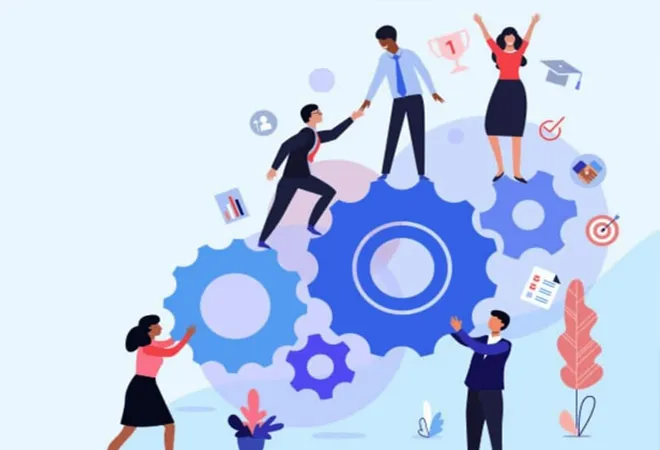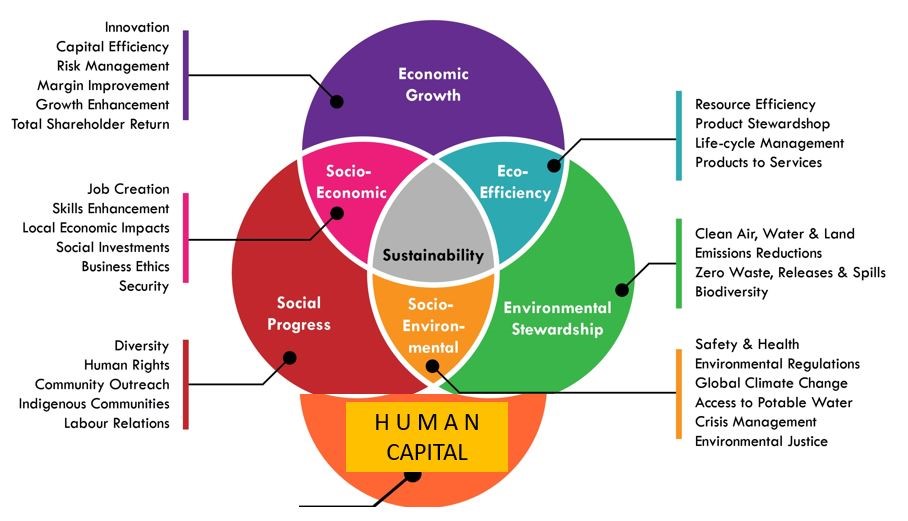 Human capital investment
Human capital investment is an essential element of sustainable development, as it promotes economic growth, social advancement, and environmental sustainability. It is a key component of
India's development strategy—to invest in its people, especially in education, health care, and skills development, to promote sustainable economic growth, alleviate poverty, and attain social development objectives. Beyond economic benefits, education and
skills development empower individuals, promote social mobility, and reduce disparities. Through education and skills development, people gain access to better job opportunities, thus, improving living standards and reducing poverty. Figure 1 below indicates the four pillars of sustainability, namely, social, environmental, economic and human.
Human capital is integral to sustainability and involves the acquisition of the necessary skills to support the functioning and sustainability of an organisation and to contribute to the well-being of societies and communities.
Figure 1: The four pillars of sustainability

India is ranked 116
th out of 174 countries on the Human Capital Index 2020. India accounts for 3 percent of the world's
malaria burden and over a quarter of the world's
tuberculosis cases. India spends
1.26 percent of its GDP on health, and 3 percent on education. According to the
Economic Survey 2021, high out-of-pocket-expenditure (OOPE) on health contributes to India's poverty. It recommends re-prioritising public health expenditure to achieve the 2.5-percent target set by the
National Health Policy to help bring OOPE down to 30 percent of healthcare expenditure compared to the current 65 percent.
The gender gap in literacy in India has narrowed, but there is still a gap of 16.9 percent between males and females.
India has come a long way in terms of
literacy, but it is still home to 313 million people who are illiterate, with 59 percent of them being women.
Government data shows a huge gap between urban and rural India when it comes to education. In urban areas, 35.8 percent have completed secondary and higher secondary education, while in rural areas it is only 24.9 percent. The
percentage having completed their education up to the graduate level and above varies between rural and urban areas, ranging from 5.7 to 21.7 percent in rural and urban areas respectively. The gender gap in literacy in India has narrowed, but there is still a gap of 16.9 percent between males and females. Only 14.9 percent of rural households had
internet facility as compared to 42 percent of urban households.
India has made significant efforts to improve access to quality education and enhance educational outcomes. The government has implemented various initiatives, such as the
Sarva Shiksha Abhiyan and the
Right to Education Act, to ensure free and compulsory education for children up to the age of 14. Additionally, programmes like the
Rashtriya Madhyamik Shiksha Abhiyan and the
Atal Innovation Mission aim to promote secondary education and encourage innovation and entrepreneurship among students. India has also focused on skill development to enhance employability and bridge the gap between industry requirements and workforce skills. The government's flagship programme, the
Pradhan Mantri Kaushal Vikas Yojana, aims to provide skill training to millions of youth across various sectors. Additionally, the
National Skill Development Corporation collaborates with industry partners to create skill development programmes and promote apprenticeships.
India has also focused on skill development to enhance employability and bridge the gap between industry requirements and workforce skills.
India is all about improving healthcare services and making sure people have access to affordable healthcare. The government has launched the
Ayushman Bharat (National Health Protection Scheme), having Health and Wellness Centers at the primary level, and the Pradhan Mantri Jan Arogya Yojana that provides health insurance coverage for economically vulnerable sections of the population. These initiatives aim to bridge the gap in healthcare infrastructure, provide essential services, and reduce OOPE. India's human capital investment efforts are also geared towards promoting
inclusive development and addressing social disparities, with programmes like
Beti Bachao, Beti Padhao (Save the Girl Child, Educate the Girl Child) and
Swachh Bharat Abhiyan (Clean India Campaign) that focus on establishing gender equality, improving access to education and healthcare, and promoting hygiene and sanitation, respectively.
However, challenges remain, such as
inequalities in access to education across urban and rural areas, gender, and
socio-economic backgrounds. The
skills acquired through education are often not matched with the skills needed in the job market, resulting in unemployment. The lack of
infrastructural facilities, such as
schools, vocational training centres, and
health facilities, hampers the growth of human capital; especially in rural areas, there is a lack of these resources.
Gender inequalities persist, particularly in education and participation in the workforce.
Women’s empowerment through education and equal employment opportunities are essential for unlocking India’s human capital potential. A large portion of
India’s workforce is employed in informal sectors, which often lack job security, social protection, and skill development opportunities. According to the
Centre for Monitoring Indian Economy Private Limited, the unemployment rate in India remains high at 8.2 percent and has been on the rise since the beginning of 2023.
Women’s empowerment through education and equal employment opportunities are essential for unlocking India’s human capital potential.
According to the
World Bank, investing in human capital is the most significant long-term investment a country can make for its future prosperity and people’s well-being. By addressing challenges related to education, skills mismatch, healthcare access, and gender inequality, India can harness its human potential to drive economic progress and social advancement.
Public-private partnerships are integral to effective human capital investment. Collaboration between government bodies, private enterprises, and civil society can pool resources, expertise, and innovative approaches. Strategic investments, policy reforms, and collaborative efforts are vital in shaping a workforce that is not only productive but also adaptable to the evolving demands of a dynamic global economy. In embracing a holistic approach to human capital development, India can position itself as a leading contender in the global arena while ensuring that growth is equitable, inclusive, and enduring.
Shoba Suri is a Senior Fellow at the Observer Research Foundation.
The views expressed above belong to the author(s). ORF research and analyses now available on Telegram! Click here to access our curated content — blogs, longforms and interviews.





 PREV
PREV


